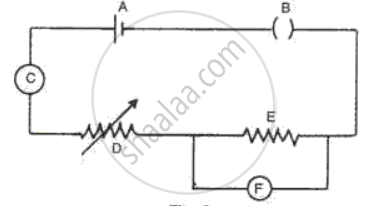Advertisements
Advertisements
प्रश्न
In the circuit shown below in Fig, calculate the value of x if the equivalent resistance between A and B is 4 Ω.

उत्तर
r1 = 4 Ω
r2 = 8 Ω
r3 = x Ω
r4 = 5 Ω
Rs1 = r1+r2
= 4 + 8
= 12 Ω
Rs2 = r3 + r4
= x + 5 Ω
`1/"R" =1/"Rs"_1 + 1/"Rs"_2`
`1/4 = 1/12 + 1/(5+x)`
`1/6=1/(5+x)`
x = 1 Ω
APPEARS IN
संबंधित प्रश्न
Is Ohm’s law universally applicable for all conducting elements? If not, give examples of elements which do not obey Ohm’s law.
What is Resistivity?
The resistors R1, R2, R3 and R4 in the figure given below are all equal in value.

What would you expect the voltmeter A, B and C to read assuming that the connecting wires in the circuit have negligible resistance?
Show by a diagram how two resistors R1 and R2 are joined in parallel. Obtain an expression for the total resistance of the combination.
Fig. represents the circuit used for the verification of Ohm's law. Label the parts from A to F. state the function of each.

State and define Ohm’s law.
Write a short note on superconductors?
Explain the equivalent resistance of a series resistor network.
A current of 2amp flowing through a conductor produced 80 joule of heat in 10 sec. The resistance of the conductor is:-
Suppose there is a circuit consisting of only resistances and batteries and we have to double (or increase it to n-times) all voltages and all resistances. Show that currents are unaltered. Do this for circuit of Example 3.7 in the NCERT Text Book for Class XII.
